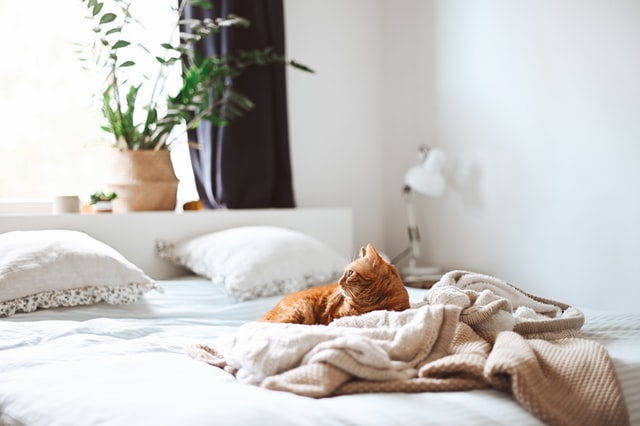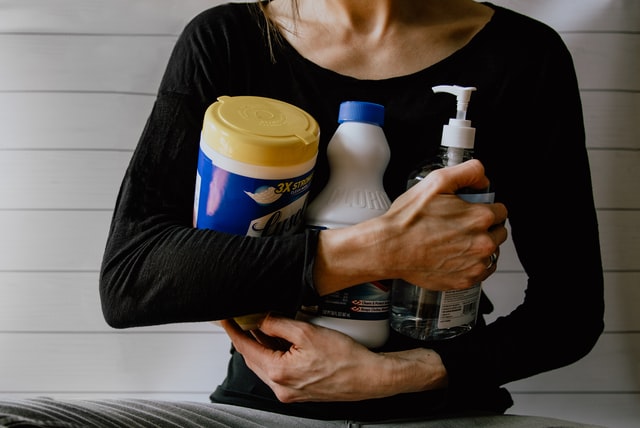3 Steps to Getting Cat Urine off Furniture
Felines are so cuddly and cute that you want to hold them on your lap all day long. But not when they’re bypassing their litter box and urinating all over your furniture. The stench is incredibly annoying and downright embarrassing when you have guests over. Not to mention, you have to deal with ugly stains that seem impossible to get rid of.
But don’t get rid of your furniture (or cat) just yet. With the right procedure, you should be able to do away with the odor and get your furniture looking as good as new within no time. We’ve provided a detailed guide on how to get cat urine off upholstery, the right products to use, and ways to discourage your cat from peeing on the furniture. Let’s jump right in.
Blot and Press Down Using a Paper Towel
If you’re like most people, your first instinct after noticing a urine stain on your furniture is to scrub it off the surface. Resist the urge to do this. Rubbing makes matters worse because it spreads the stains to other parts of your furniture. Besides, you risk damaging delicate upholstery in the process.
Instead of rubbing, take a paper towel or piece of cloth and press it down where the stain is. Doing so absorbs all the urine from the spot without spreading it. If the cloth or paper towel gets soaked with the urine on your first attempt, repeat until there’s only a little amount on the towel.
Once you’re done, take another dry piece of cloth or paper towels and leave them on the spot to soak up even more urine. Leave the towels in the spot for a few hours or overnight depending on how much urine there is.
Get Rid of the Odor Using an Enzymatic Cleaner
Another mistake feline owners make is using the wrong cleaners to clean cat pee off furniture. Water-based cleaners won’t fix the problem. The uric acid in the cat’s pee is not water-soluble. Therefore, when you use a water-based cleanser, it will only mask the stain but won’t get rid of the odor.
As a result, your cat will smell the odor and pee on the same spot over and over again. Not to mention, you’ll have to deal with the unpleasant smell. The solution is to use an enzymatic cleaner. Such cleaners break down the uric acid and eliminate the odor.
However, for this to work, you need to use the cleaner well. First, you need to ensure you’ve soaked the soiled area with the enzymatic cleaner, making sure the cleaner goes as deep as the urine did. Afterwards, leave the cleaner to sit for about 15 minutes before proceeding to the next step.
Note: Enzymatic cleaners are quite strong and may cause stains or remove dye from your furniture. For this reason, it’s crucial to do a patch test on a small area of your furniture before you begin cleaning. Some of the best enzymatic cleaners for furniture on the market include:
Simple Solution Extreme Stain & Odor Remover
When your feline is marking their territory, chances are they won’t just pee on your furniture. Cats pee all over the house on floors, carpets, and other areas they shouldn’t. Therefore, you need a cleaner that can get rid of those stubborn stains on multiple surfaces.
The Simple Solution Extreme Stain and Odor Remover is not only incredible for furniture but also carpets and hard surfaces. This enzymatic cleaner soaks deep into the upholstery, leaving the spot clean and smelling fresh.
Another feature we love is its 3-in-1 sprayer, i.e. mist, foam, and stream. If you have surface stains, you can use the mist sprayer option. The foam sprayer is excellent for embedded stains, and the stream sprayer does an incredible job of eliminating odors. This cleaner is also safe to use around children and pets.
Black Diamond Ur-In Control
Another excellent cleaner worth investing in is the Black Diamond Ur-In Control. This cleaner is useful for getting rid of different kinds of pet stains around the home. It works on furniture, mattresses, and carpets, and can be used to freshen up your pet’s beddings, litter boxes, and crates, and your Gold Coast cat kennels, among other things.
According to the manufacturer, this cleaner is safe to use on any surface that wouldn’t be harmed by water. Furthermore, it’s environmentally friendly and safe to use around pets. Users have also attested to the fact that the cleaner doesn’t just mask the smell; it gets rid of it completely.
And if you’re worried about spending your hard-earned money on a product that may not work, you don’t have to. The manufacturer offers a 100% money-back guarantee if you’re not satisfied. It’s, therefore, a risk-free purchase.
Nature’s Miracle Urine Enzymatic Formula
Nature’s Miracle Urine Enzymatic Formula is another product you won’t regret buying. Like most enzymatic cleaners, this one penetrated deep into the soiled surface, breaking down the uric acid. It eliminates stains and eradicates the odor in the process.
We also love that it’s safe to use around kids and pets and that it’s easy to use. You also get a money-back guarantee in case you’re not satisfied with the results. Therefore, you have nothing to lose if you decide to try this product.
Cover the Affected Area and Leave it to Dry
Once you’ve applied the enzymatic cleaner on the soiled area, you need to leave the spot undisturbed for a few days. You see, if the stain and cleaner are soaked deep inside the furniture, it may take a few days to completely dry. Therefore, cover the spot with a fabric, towel, or anything else that will keep people and pets from the area.
Alternatively, you can take the cushions outside to dry in the sun. This way, you don’t risk the feline soiling the spot again, and you speed up the drying process.
Source: Crookston Pet Clinic

Enzymatic Cleaner Alternatives
If you don’t have an enzymatic cleaner and you don’t have the time to rush to the store to get one for whatever reason, there are alternative cleaners you can use. However, bear in mind that these cleaners may not be as effective as enzymatic cleaners.
Baking Soda and Vinegar
Baking soda and vinegar do wonders in getting rid of urine stains and masking odors. You’ll need:
- Baking soda
- Distilled white vinegar
- Cloth or paper towel
- Spray bottle
- Water
To clean the urine stain:
- Use a piece of dry cloth or paper towel to soak up as much urine from the upholstery as possible. Remember, you should use a pressing motion and avoid rubbing the stain to prevent spreading it.
- Sprinkle generous amounts of the baking soda on the stain and let it sit undisturbed for approximately 5 minutes. The baking soda deodorizes the stain.
- Mix equal parts of water and the distilled white vinegar in a spray bottle. Spray the mixture on the area already covered with baking soda and let it sit for another five minutes.
- Blot the area with paper towels or a piece of cloth to dry it.
- Repeat as needed.
Baking Soda, Dish Soap, and Peroxide
Another excellent homemade cleaner you can use is the baking soda, dish soap, and peroxide cleaner. To make this cleaner, you’ll need the following:
- Baking soda
- Dish soap
- Hydrogen peroxide
- Grease cutting dish soap
- Towel
- Paper towels
- Bowl
To clean:
- Begin by soaking up as much of the urine as possible using paper towels, making sure not to rub the area to avoid spreading the stain.
- Next, liberally sprinkle some baking powder on the soiled spot and let it sit undisturbed for 5 minutes.
- In a bowl, mix one teaspoon of the dish soap with ½ cup of 3% hydrogen peroxide
- Pour the dish soap and hydrogen peroxide mixture onto a towel and blot it on the stain. The dish soap will get rid of the odor creating fatty acids, and the hydrogen peroxide will remove all crystals that form stains on the upholstery.
- Repeat as needed until the odor is completely gone.
Water and Vinegar
Another simple homemade cleaner that’s effective for getting rid of urine stains and odor is water and vinegar mix. For this cleaner, you’ll need:
- Paper towels
- Vinegar
- Warm water
- Spray bottle
To clean:
- Begin by soaking up as much of the urine as possible using paper towels.
- Next, mix 1 ½ cups of warm water with ½ cup of vinegar in a spray bottle.
- Pour the concoction onto the soiled area and leave it to soak for about 3 to 5 minutes.
- Blot out the excess using paper towels. Alternatively, you can leave the cushions outside to dry in the sun.
- Repeat as needed until the odor is completely gone.
Note: If you’re using any of these homemade cleaners on leather, you should apply a leather conditioner on the furniture when the spot is completely dry since some of the ingredients in the mixtures are known to dry out leather.
Advanced Baking Soda Spray
If you want to avoid the hassle of applying baking soda on your upholstery and cleaning it up, you may want to try a spray-on solution. For this method, you’ll need the following:
- Baking soda
- Spray bottle
- Warm water
- Paper towels
- A scented oil like lavender oil
To clean:
- Begin by soaking up as much of the urine from the furniture as possible using the paper towels.
- Next, in a spray bottle, mix 2 to 3 tablespoons of baking soda, a few drops of the lavender oil, and warm water. You must follow these measurements. Too much scented oil will be overpowering and too much baking soda will leave a residue on your furniture.
- Shake the mixture thoroughly to get an even mix and spray it on the affected area.
- Leave the cushions out to dry.
- Repeat the steps as needed if the odor is still there.
Baking Soda and Vacuum
If you have furniture that’s covered using a delicate fabric, some of the above methods may damage the fabric. In such scenarios, you can use the baking soda and vacuum method. The process is quite simple. All you need to do is to add the baking soda in a salt shaker and sprinkle it liberally on the affected area.
Once you’re done, leave the baking soda to sit undisturbed for up to an hour or overnight if the area is badly soiled. Leaving the baking soda on the spot for an extended period is crucial because it takes time for the baking soda to act,mainly when used alone.
Afterward, use a vacuum cleaner to clean the spot. You should notice a significant difference in the odor. This method is best for dried up urine stains that leave an odor.

Get Rid of the Odor with Activated Charcoal
As we mentioned, some of these DIY cleaners may not be as effective as using an enzymatic cleaner. As a result, you may find that there’s still an unpleasant odor on your furniture even after cleaning a couple of times. When this happens, you can use activated charcoal to get rid of the smell.
You see, activated charcoal is an even better adsorbent and odor-killer compared to baking soda. However, you should not apply it onto your furniture as you would baking soda because it would stain your furniture.
Use fresh bags of activated charcoal. Hide them in the corners of your furniture, close to where the odor is. Over time, you should notice an improvement in the smell.
Source: Family Handy Man
Get to the Root of the Problem
If you don’t take the time to find out why your cat is suddenly peeing all over your furniture and bypassing their litter box, you may be cleaning pee off surfaces for a long time. And if you leave your cat with a Gold Coast cat carer, they may take the habit to the establishment as well. There are plenty of reasons why felines exhibit inappropriate urination behavior. These include:
Stress
Felines are creatures of habit and will react negatively to even the slightest change in their environment. A new baby, your absence, or even a new cat in the neighborhood is enough to stress your cat out. One of the ways felines deal with stress is by marking their territory. They do so by leaving their urine scent on surfaces. It’s their way of saying they’re stressed.
Illness
When your cat has a urinary tract infection or blockage, they may also start exhibiting bad urination behaviors. You’ll notice the cat has stopped using their litter box and spends a lot of time trying to urinate or licks their genitals. In some cases, the cat may pee in the bathtub or sink to alert you that there’s a problem.
If you suspect that your cat may have a medical issue that’s causing the bad urination behavior, see a vet immediately. Problems like urinary tract infections and blockages won’t go away on their own, and they could be fatal. Other problems may include serious blockages, like kidney stones. Keep an eye out for discolored urine.
New Pets in the Home
Your fur baby may also start marking their territory when you bring home a new cat. They see the new addition as a stranger who’s invading their territory. As a result, they feel the need to mark their territory. You should give your cat some time to get used to the new addition to the home and never expect your cat to share a litter box with their new buddy.
Mating Behavior
Felines that have not been spayed or neutered have a strong urge to spray, and they’re not selective about where they do it. They’ll do it on your furniture and any other object they find as long as their urge is dealt with. The solution for this is to have the cat neutered as soon as you adopt him. However, the longer you wait, the more likely the habit will be ingrained.
Source: The Humane Society of the United States
Time to Clean Up
If you’ve tried everything you can to get rid of urine stains and odor without any luck, it may be time to try an enzymatic cleaner. Enzymes are effective for these kinds of stains because they break down the uric acid that causes the odor. What’s more, the cleaners get deep inside the upholstery making sure the spot is free from any stains after cleaning.
However, make sure you get a cleaner that’s safe for the fabric you intend to use it on and do a patch test before using the cleaner on your furniture. And if you’re cleaning leather, always use a conditioner after the cleaning process to prevent the fabric from drying up.
Most importantly, ensure you find out why your cat won’t stop peeing on furniture. Otherwise, you’ll always have to clean up messes on your furniture and other parts of the home.
